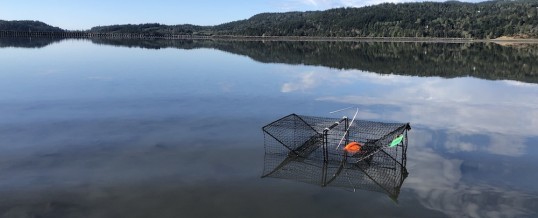
December 31 2022
We spend a lot of time thinking about how to quantify green crab efforts and numbers to understand status and trends. Suffice to say that any way you slice it, any way you define and quantify metrics, 2022 was a big year in Washington for European green crab management. With the launch of the Governor’s Emergency Order and WDFW-coordinated response measures, this year brought more collaborative partnerships, more gear, more trap sets, and–yes–more crabs than any year in the state’s history. While we can’t hope to even summarize everything of note this past year, over a series of three posts, we’ll provide reflections and highlight some notable trends and accomplishments for 2022. You can also find much more information and detail on activities related to green crab management at the WDFW green crab webpage.
This first post in the series will focus on patterns in the status and trends of green crab along inland shorelines (with the exception of the Lummi reservation, a longer story that can be best detailed by partners trapping for the Lummi Nation). In the coming weeks, we’ll share a similar post related to coastal geography, as well as a wrap up post, comparing and reconciling the observations across the broader geography. Stay tuned.
New Detections
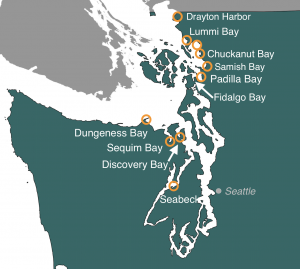
A map of capture locations for European green crabs along inland shorelines of Washington in 2022 (orange circles). Sites referenced in this article are labeled, including Fidalgo Bay, where no live crabs were captured. Click to enlarge.
Along inland shorelines, green crabs were detected in two new water bodies in 2022: Hood Canal and Discovery Bay.
Discovery Bay
Biologists trapping with WDFW and the Jamestown S’Klallam Tribe captured the first green crabs to be observed in Discovery Bay in early August. In some ways the detection was not entirely surprising, because green crabs have been sparsely detected in Sequim and Dungeness Bays to the west, and the Port Townsend area just to the east, going back as far as 2017. What was surprising, however, was that, based on the overall catch rate of about 12 crabs for every 100 trap sets*, and size of the crabs captured (ranging up to 88mm), green crabs have apparently been present undetected in Discovery Bay for a few years. Crab Team and WDFW have both trapped this site in previous years with no detections, including at the ongoing Crab Team monitoring site (where, to date, no green crabs have been captured), and a broader exploratory trapping effort by WDFW in 2018. So far, crabs appear to be most densely concentrated in two creeks flowing into the head of the bay, as well as a recently restored lagoon. Notably, all of these sites have moderate freshwater input as a habitat feature, but broader scale and more intensive trapping of Discovery Bay is needed to determine whether these will remain local hotspots. The overall catch rate in Discovery Bay of about 12 crabs for every 100 trap sets is on par with the highest rate observed along inland shorelines to date, with the exception of Lummi Sea Pond which is typically considered a special case due to the artificial nature of the habitat. Notably, the only other site to achieve such a high catch rate was Drayton Harbor for this year (see below).** As such, this area is a significant concern as an establishment risk.
Hood Canal
The capture, by Crab Team volunteers, of green crabs in Hood Canal for the first time was also greatly concerning. Following the capture during monthly monitoring at Nick’s Lagoon in Seabeck, WDFW and WSG conducted a series of follow up trapping efforts in the area. In addition WDFW technicians trapped other sites with suitable habitat in the northern part of Hood Canal, including Shine Tidelands and Dabob Bay, as well as at the mouths of the Dosewallips and Duckabush Rivers. These trapping efforts only yielded a very small number of green crabs outside of Nick’s Lagoon, all of which were in the vicinity of Seabeck. However, Crab Team volunteers did find a molt from a European green crab at Shine Tidelands, just north of the Hood Canal bridge, while conducting a beach survey for another citizen science project. There is still a great deal of relatively unexplored suitable habitat in Hood Canal, and so ongoing exploration of untrapped sites will be an important activity for 2023. In all, the catch of crabs in the Seabeck area this year was 17 crabs in 622 traps, for an average rate of 2.7 crabs for every 100 traps set, on par with a few other hotspots in the Salish Sea. While this number is relatively low among observations this year, more trapping will be necessary to remove remaining crabs and ensure numbers stay low.
Annual Trends
When painting a regional picture of green crab status, we take into account not only how many new detections there have been, but also tracking the year-to-year changes in catch rates. Many folks have heard about the astounding numbers of crabs that have been removed from Washington this year (more than 80,000 across inland shorelines alone), but in order to look at year-to-year changes, we need to account for different levels of trapping effort each year. Catch rate (the number of crabs on average that is captured in a given number of traps) is not a perfect metric for population size, but provides a better way to get a rough look at how population size might be changing over space or time than just looking at the number of crabs removed. With highly invasive species like green crab, quite often the populations spend a few years at low abundance before apparently “exploding”. The goal of ongoing intensive control trapping at sites where small or moderate numbers of green crabs have been found in the past is to keep this from happening.
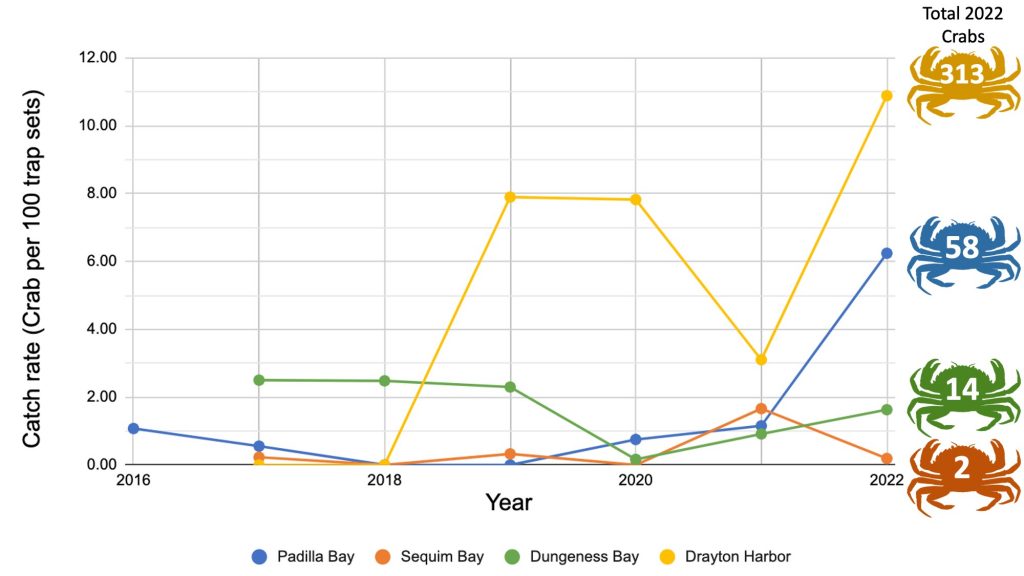
Figure 1. Average annual catch rates, in number of green crabs per 100 trap sets, from 2016 through 2022. The total number of crabs captured in 2022 at each of the site is indicted in the crab of the same color to the right. Click to enlarge.
Across inland shorelines, a few water bodies have been trapped consistently for the past several years in large scale efforts, so we can evaluate progress toward the goal of controlling population size and reducing the chance of spread by tracking catch rates from year to year. At the four of these sites (Figure 1) that have been tracked the longest, catch rates remained relatively low in 2022, but some geographic patterns did emerge. In Sequim Bay, biologists with Jamestown S’Klallam and WDFW, thankfully, had a very hard time finding green crabs this year. At Dungeness Bay, US Fish and Wildlife Staff trapping at the refuge noted another slight increase in catch rate this year relative to 2021. But overall catch rates remained below two crabs in every 100 trap sets at both of these sites on the North Olympic Peninsula. By contrast, in the northern portion of Washington’s inland shorelines in Whatcom and Skagit counties, catch rates in Drayton Harbor and Padilla Bay jumped substantially this year, exceeding any previous year on record. Located between these two water bodies, Northwest Straits Commission conducted their first season of removal trapping in Samish Bay this year, adding to the ongoing trapping efforts by Bill and Andy Dewey on shellfish beds owned by Taylor Shellfish. In total, the two groups removed 135 green crabs from Samish Bay which is only very slightly elevated compared to last year’s total of 119, and given the increase in trapping effort, catch rates in this bay have actually declined somewhat. Overall, even where they have increased, all of these catch rates still remain well below many sites in Washington’s coastal estuaries (stay tuned for our upcoming post) or within the sea pond on the Lummi Reservation, but any such large increase is always a cause for concern and ongoing intensive management.
Seasonal Trends
Seasonally, 2022 was a late year for inland green crabs. Last winter had two intense cold snaps, and a long, slow warm up to spring. While many of us were eager for the sun and heat to get a move on, those conditions delayed the onset of what we call “the spring jump” in green crab captures. In years past, catch rates have often bumped up in late May and early June, then dropped for a few months before the arrival of the new cohort of young-of-the-year crabs in traps in August or September. This year, that first jump didn’t start until July in Drayton Harbor (Figure 2).
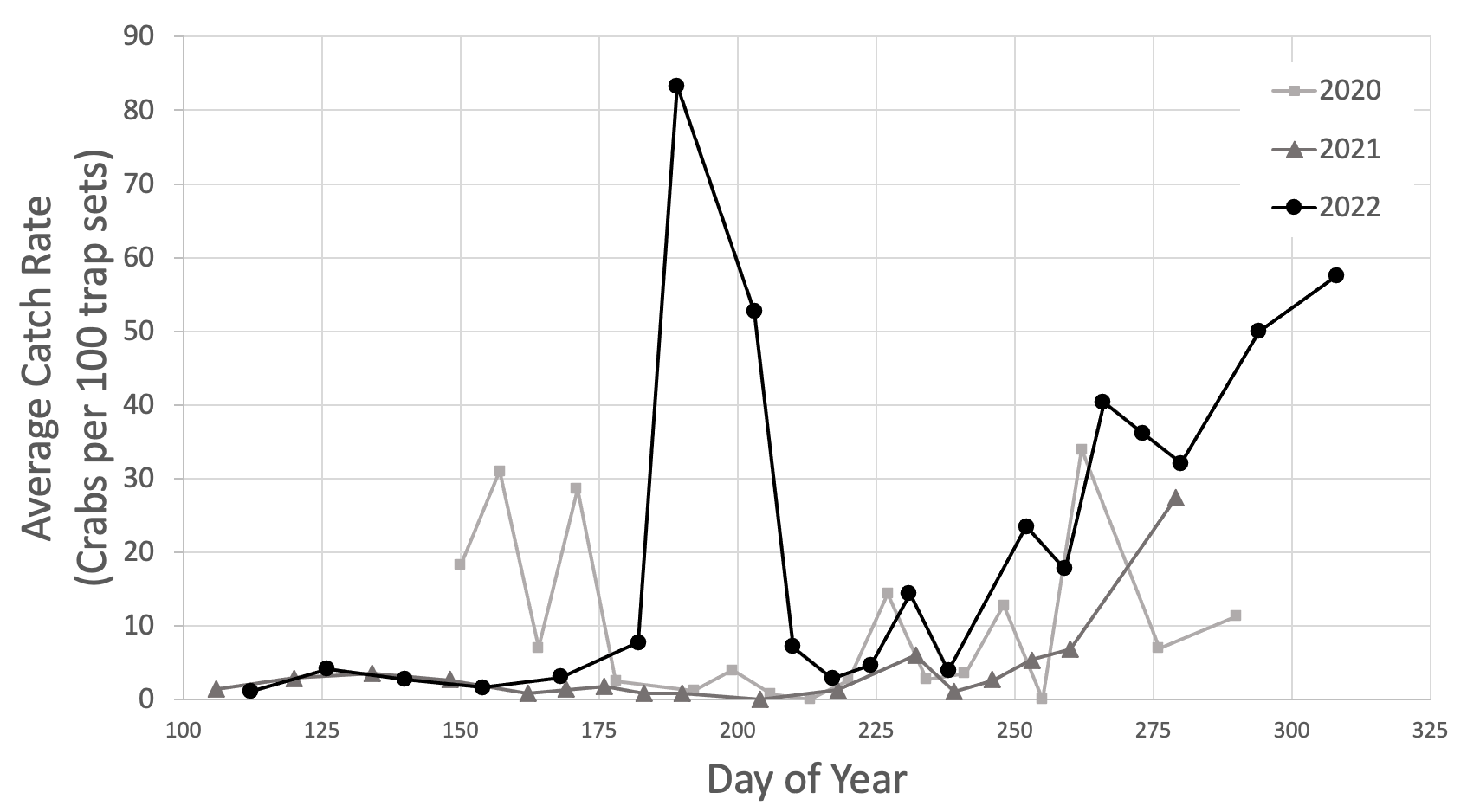
Figure 2. Weekly average catch rate of green crabs in Drayton Harbor by day of year for 2020 through 2022. Click to enlarge.
The arrival of the young of the year cohort in Drayton, the time of year when the youngest crabs get large enough to start entering traps, was also 2-4 weeks later than 2021 and 2020, respectively. Interestingly this year, a smattering of relatively small crabs (<50mm) were being caught in July and August, in a few locations, including Drayton. Typically, by that time of year, last year’s recruits have already molted past that size. There are two possible explanations, either the delayed spring might have stalled typical seasonal growth patterns for some 2021 crabs, or, as has increasingly been observed in coastal estuaries, green crabs are having a more protracted reproductive season, and these crabs were on the very late end of reproduction for 2021 crabs, possibly the lucky few to survive some of the extreme cold snaps. Given the cold conditions, it seems unlikely these runts were early 2022 crabs.
However late, the 2022 cohort of young of the year did ultimately arrive, and did so in force. The young of the year cohort was strong this year, particularly in Whatcom and Skagit Counties. Totaled over the season, about half of all the crabs captured in Drayton Harbor in 2022 were young of the year individuals, and in Padilla Bay, all but 6 of the 58 crabs captured also appear to be recent arrivals. This apparent reproductive success foreshadows the potential of higher catch rates next year when the trapping season resumes.
Fall weather also arrived fashionably late, an unusually warm September and October actually enabled trappers with NWSC and Padilla Bay NERR to extend their trapping later into the year. Typically, catch rates drop off by late October, as green crabs reduce their activity with the arrival of cool weather. While temperatures remained unseasonably warm into November this year, these groups all observed that catch rates of crabs, both young and old, were sustained, and even increased at the very tail end of trappable tides this year. Some inland trapping groups are experimenting with subtidal trapping during the winter, to determine whether this work can efficiently continue to find and remove crabs, even if at lower rates than warm-season trapping.
Other notables
A few other sites had detections and captures that were noteworthy as well. This year Crab Team volunteers in Chuckanut Bay captured their first green crab in their monthly early detection monitoring traps. Green crabs have been extremely rare in Chuckanut, but detected at least once per year, either as molts or live crabs within Mud Bay since first being found there in 2019.
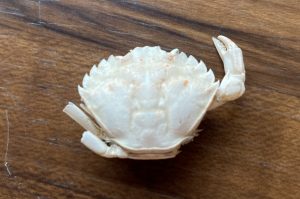
Green crab molt found by Crab Team volunteers at the Fidalgo Trestle site in September. Photo: Paul Dinnel
Not far to the south, managers are looking at Fidalgo Bay, in Skagit County, with a similar concern. Given the proximity to Samish Bay, and Padilla Bay, where green crabs were first spotted in 2016, it seems very likely that green crabs could also be found in small numbers in Fidalgo, which is home to a state Aquatic Reserve as well as tidelands important to the Swinomish Indian Tribal Community and Samish Nation. Indeed, back in 2018, a single green crab molt was found at a beach in Fidalgo Bay, but no further evidence was found either in follow up trapping, or at the three Crab Team sites that have continued to operate in the bay. This year, with added staff capacity with Northwest Straits Commission, a huge collaboration of staff across nine agencies and tribes converged on Fidalgo for a week of trapping – no evidence of green crab turned up in more than 736 trap sets. Just a week later Crab Team volunteers conducting their regular monthly monitoring collected a single young of the year green crab molt during their surveys – indicating that at least one green crab managed to elude trappers. Traps will be out again in 2023 in the hopes of catching that crab, and any others that might have done the same.
Next up, we focus on trapping efforts and observations in Washington’s coastal estuaries in 2022.
–Emily Grason
*Data are still in the process of being fully verified and finalized by some trapping partners, and while the numbers shared here are likely to be relatively close to final totals, they may change somewhat as a result of the final QA and/or differences in effort calculation.
**Wording here was amended on 1/11/23 to clarify the intention was to compare catch rates in Discovery Bay to those in Drayton Harbor. Previous language was unclear and may have been interpreted as suggesting comparability to catch rates within Lummi Sea Pond, which is inaccurate.
DEC
2022